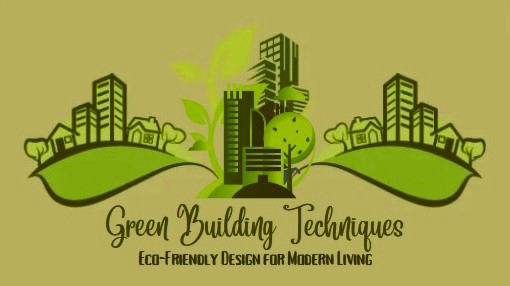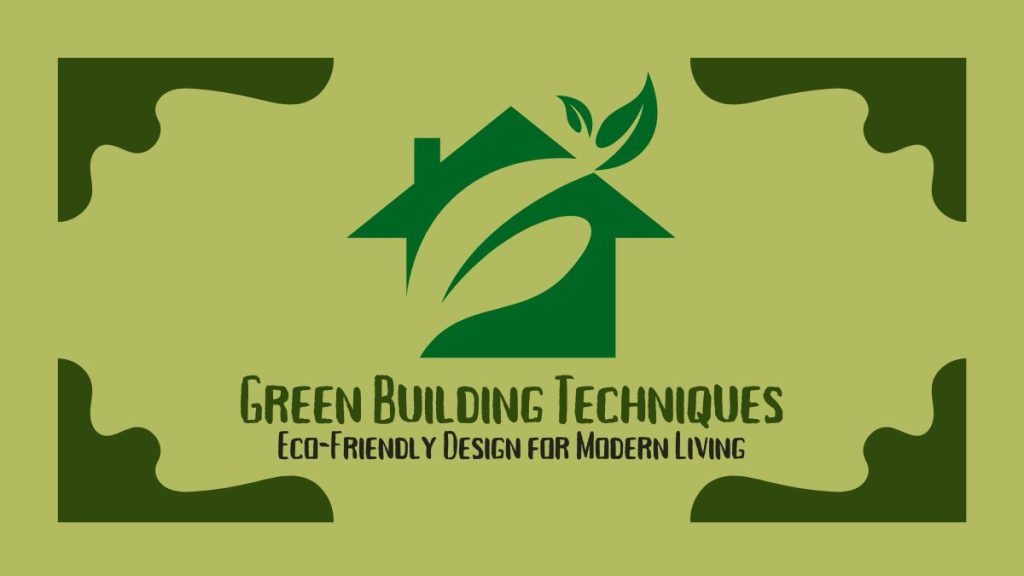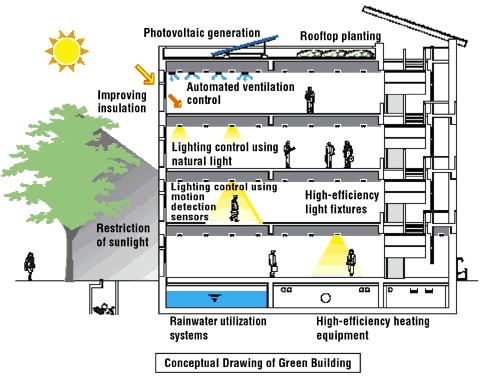Green building techniques involve sustainable practices to create energy-efficient, eco-friendly structures. These methods reduce environmental impact and enhance occupant well-being.
Green building techniques focus on using renewable resources, reducing waste, and improving energy efficiency. Solar panels, green roofs, and rainwater harvesting systems are popular methods. Natural ventilation and insulation materials minimize energy consumption. Sustainable building materials like reclaimed wood and recycled metal reduce carbon footprints.
Smart home technology optimizes energy use, enhancing efficiency. Green buildings often include indoor plants for better air quality. These methods not only benefit the environment but also lead to cost savings. Implementing green building techniques promotes a healthier lifestyle and supports sustainable development. They represent a crucial step towards a more sustainable future.
Related Article: Urban Design Principles: Transforming Cities for the Future

Related Article: How Can Landscape Architecture Serve the World Today
Introduction To Green Building
Green building techniques are transforming how we design and construct buildings. These methods focus on sustainability, energy efficiency, and reducing environmental impact. By adopting green building practices, we can create healthier and more sustainable living spaces.
What Is Green Building?
Green building refers to the practice of creating structures using processes and materials that are environmentally responsible. It involves every stage of a building’s life cycle, from design to construction, operation, maintenance, and demolition.
- Reduces waste and pollution
- Uses renewable resources
- Enhances energy efficiency
- Improves indoor air quality
Importance Of Sustainable Design
Sustainable design is crucial for preserving our environment. It helps reduce the negative impact on natural resources. Sustainable buildings use less energy and water, reducing utility bills and operational costs.
| Benefits | Description |
|---|---|
| Energy Efficiency | Reduces energy consumption through better insulation and efficient systems. |
| Water Conservation | Uses low-flow fixtures and rainwater harvesting systems. |
| Healthier Living | Improves indoor air quality with non-toxic materials. |
- Reduces strain on local resources.
- Lowers greenhouse gas emissions.
- Promotes a healthier lifestyle.
Implementing green building techniques and sustainable design can significantly impact our planet’s future. Adopting these practices creates a better environment for everyone.
Related Article: Mixed Use Development: Unlocking Urban Innovation and Growth

Credit: blog.attuneiot.com
Related Article: Urban Design Ideas: Transform Your Cityscape with Innovation
Energy-efficient Solutions
Energy-efficient solutions are essential for green buildings. They help reduce energy consumption and lower costs. These solutions also promote sustainability. Below, we explore two key methods: solar power integration and smart home technologies.
Solar Power Integration
Solar power is a clean energy source. It harnesses sunlight to generate electricity. Installing solar panels on rooftops is popular. Panels can also be integrated into building materials.
Benefits of solar power include:
- Reduced electricity bills
- Lower carbon footprint
- Energy independence
Solar power systems can be connected to the grid. This allows excess energy to be sold back. It provides additional savings.
Smart Home Technologies
Smart home technologies optimize energy use. They include devices like smart thermostats and lighting systems. These devices can be controlled remotely.
| Device | Function |
|---|---|
| Smart Thermostat | Adjusts temperature based on occupancy |
| Smart Lighting | Controls lights based on usage |
| Smart Plugs | Manages power to appliances |
Benefits of smart home technologies:
- Enhanced comfort
- Energy savings
- Increased convenience
These technologies also provide real-time data. This helps users understand their energy consumption. Smart homes are a step towards a greener future.
Water Conservation Methods
Water conservation is a key aspect of green building techniques. Effective methods help save water and reduce utility bills. They also protect the environment. Let’s explore some methods.
Rainwater Harvesting
Rainwater harvesting is a simple yet effective method. It involves collecting rainwater from rooftops and storing it. The stored water can be used for various purposes.
- Gardening: Use harvested rainwater to water plants.
- Flushing Toilets: It can be used for toilet flushing.
- Cleaning: Ideal for cleaning purposes.
Setting up a rainwater harvesting system is easy. Install gutters and a storage tank. Ensure the system is clean and free from debris.
Low-flow Fixtures
Low-flow fixtures help save water in homes and buildings. They are designed to use less water without compromising performance.
- Low-Flow Showerheads: These use less water during showers.
- Low-Flow Faucets: They reduce water usage in sinks.
- Dual-Flush Toilets: They offer two flush options, saving water.
Installing low-flow fixtures is a great way to save water. They are cost-effective and easy to install. They also help reduce water bills.
| Method | Usage | Benefits |
|---|---|---|
| Rainwater Harvesting | Gardening, Flushing Toilets, Cleaning | Saves water, Reduces bills, Eco-friendly |
| Low-Flow Fixtures | Showers, Sinks, Toilets | Water-efficient, Cost-effective, Easy to install |
Related Article: Smart City Design: Transforming Urban Living for the Future

Related Article: Benefits of Landscape Architecture: Enhance Your Space!
Eco-friendly Materials
Using eco-friendly materials in construction helps save the planet. These materials reduce waste and save energy. They also promote a healthier living environment.
Recycled Building Materials
Recycled building materials are made from waste items. They help reduce landfill waste and conserve natural resources.
- Recycled steel: Strong and durable, perfect for building frames.
- Recycled glass: Used in windows and tiles, giving a unique look.
- Reclaimed wood: Adds character and charm to any space.
Using recycled materials also reduces the need for new raw materials. This lowers the carbon footprint of construction projects.
Sustainable Wood Options
Sustainable wood options are sourced responsibly. They come from forests managed in an eco-friendly way.
| Wood Type | Features |
|---|---|
| Bamboo | Grows quickly and is very strong. |
| FSC-Certified Wood | Comes from well-managed forests. |
| Reclaimed Wood | Reused from old structures, reducing waste. |
Choosing sustainable wood reduces deforestation. It also supports eco-friendly forest management.
Indoor Environmental Quality
Indoor Environmental Quality (IEQ) is crucial in green building techniques. It directly impacts the health and comfort of occupants. Enhancing IEQ involves improving air quality, utilizing natural lighting, and using low-emission materials.
Improving Air Quality
Improving air quality is vital for a healthy indoor environment. Here are some effective strategies:
- Ventilation Systems: Use energy-efficient ventilation systems.
- Air Filtration: Install high-efficiency particulate air (HEPA) filters.
- Plants: Incorporate indoor plants to purify the air.
Ventilation systems help to circulate fresh air. HEPA filters remove pollutants and allergens. Indoor plants absorb toxins and release oxygen. These measures improve air quality significantly.
Natural Lighting Techniques
Natural lighting techniques enhance indoor environmental quality. They reduce energy consumption and improve mood. Here are some techniques:
- Large Windows: Install large, energy-efficient windows.
- Skylights: Use skylights to bring in natural light.
- Light Tubes: Implement light tubes to channel sunlight indoors.
Large windows allow more sunlight into rooms. Skylights are perfect for areas without side windows. Light tubes direct sunlight to darker areas. These techniques ensure ample natural lighting.
| Technique | Benefit |
|---|---|
| Ventilation Systems | Circulate fresh air |
| HEPA Filters | Remove pollutants |
| Indoor Plants | Purify air |
| Large Windows | More sunlight |
| Skylights | Bring in natural light |
| Light Tubes | Channel sunlight |

Credit: www.linkedin.com
Related Article: Green Urban Design: Transforming Cities for a Sustainable Future
Landscape And Site Design
Landscape and site design are crucial in green building techniques. They enhance sustainability and promote eco-friendly living. Thoughtful landscape and site design can reduce energy usage and water consumption. It also supports local biodiversity and improves air quality.
Native Plant Landscaping
Native plant landscaping uses plants that naturally grow in the area. These plants require less water, fertilizer, and pesticides. They are well adapted to the local climate and soil conditions. Native plants support local wildlife, providing food and shelter.
- Less maintenance required
- Reduced water consumption
- Support local wildlife
Using native plants can create a beautiful and sustainable landscape. They can help control erosion and improve soil health. Native plant landscaping contributes to a balanced ecosystem.
Green Roofs And Walls
Green roofs and walls are covered with vegetation. They provide insulation, reducing heating and cooling costs. Green roofs absorb rainwater, reducing runoff and flooding. They also improve air quality and support biodiversity.
| Benefits | Description |
|---|---|
| Insulation | Reduces heating and cooling costs |
| Rainwater Absorption | Reduces runoff and flooding |
| Air Quality | Improves by filtering pollutants |
| Biodiversity | Provides habitat for plants and animals |
Green roofs and walls can transform urban spaces. They create green oases in cities. These living structures can improve mental well-being and reduce urban heat islands.

Credit: www.ecomena.org
Related Article: How Does Architecture Help Society: Shaping Our World
Conclusion
Green building techniques offer sustainable solutions for modern construction. They reduce environmental impact and promote energy efficiency. Adopting these methods can lead to healthier living spaces. Embrace green buildings to contribute to a sustainable future. Make a positive impact on the environment with smart building choices.
Related Article: Design for Healing: Spaces that Nurture Well-being

Pingback: How Can Landscape Architecture Serve the World Today - SpaceArc
Pingback: How Does Architecture Help Society: Shaping Our World - SpaceArc
Pingback: Benefits of Landscape Architecture: Enhance Your Space! - SpaceArc
Pingback: Green Urban Design: Transforming Cities for a Sustainable Future - SpaceArc